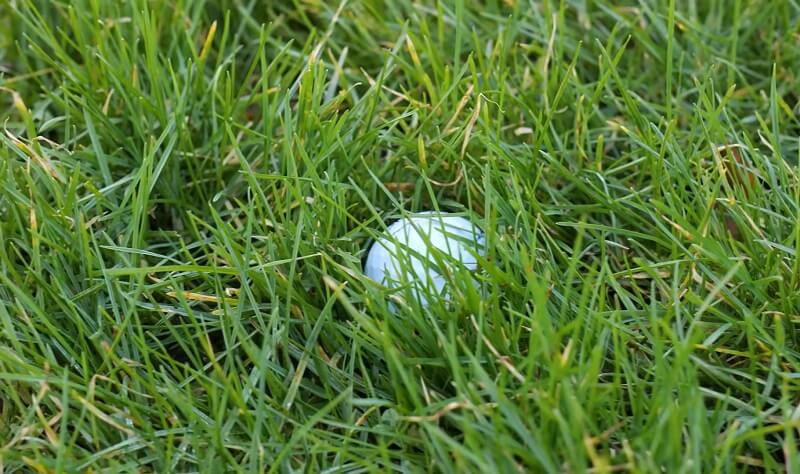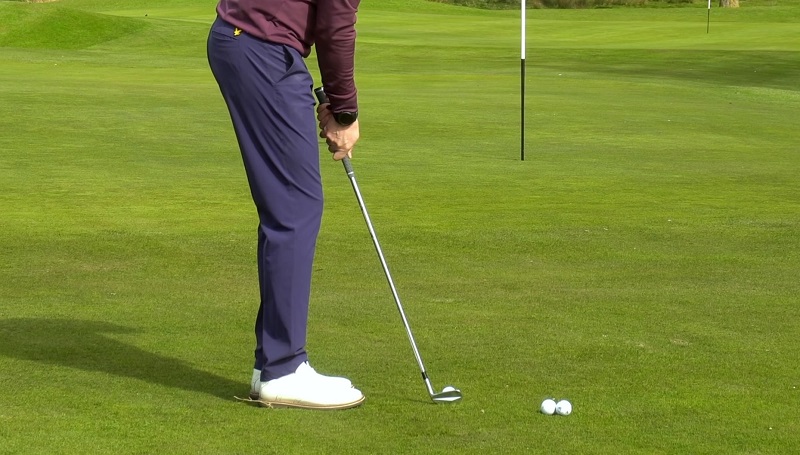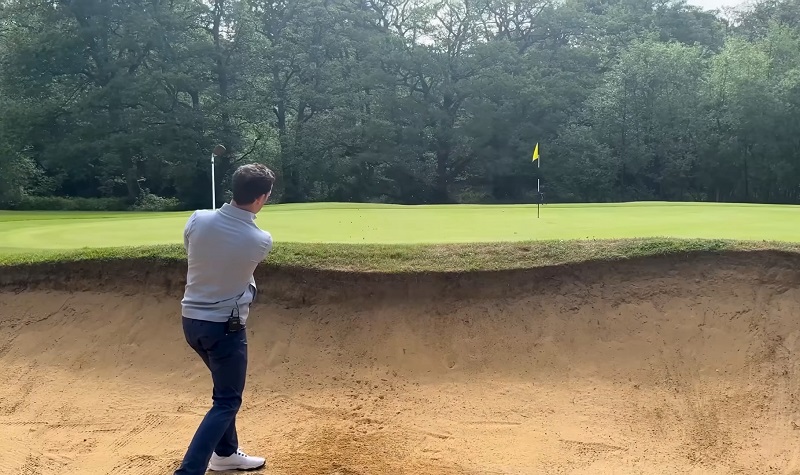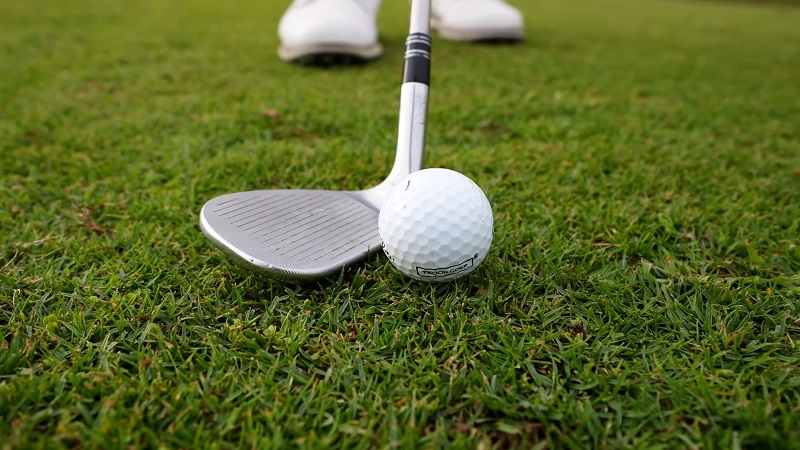Chip shots are one of the most valuable skills for a golfer to master. Chipping is used when you are close to the green and want to get your ball onto the putting surface quickly with as little effort as possible. Learning how to chip a golf ball accurately can help you lower your scores significantly. In this article, we will cover some of the basics of chipping so that you can get started on improving your game.
What Is A Golf Chip Shot?
A chip shot is a type of shot that is used to get the ball close to or into the hole with accuracy and control. It involves hitting a short, low-trajectory shot, usually from just off the green. The idea behind this technique is to land the ball softly on the greens and let it roll out toward its target.
Golfers use the chip shot to control the distance they can send the ball toward its intended target. This is usually accomplished by using more of an up-and-down swinging motion than a full swing. The club is swung with a steep angle to get the ball up quickly while maintaining power.
The chip shot can be an invaluable tool in golf, especially when approaching the green. By using this technique, golfers are able to put the ball precisely where they want it on their approach shots.
When to Use A Chip Shot?

A chip shot is best used when you need to get the ball close to the hole in a single stroke. This type of shot is often used for very short distances, typically from within 50 yards or less. The aim should be to land the ball softly onto the green and roll it toward the cup, allowing for greater accuracy and control. You should also consider using a chip shot when you need to avoid hazards such as bunkers, water, or trees that may be in your way toward the green.
This method of play offers greater accuracy and control than other options such as long irons, which require more power but tend to produce less consistent results. Utilizing a golf chip shot can also help build confidence as you practice and develop your ability to control the ball. With a chip shot, you completely control the distance and speed of your game.
Learning how and when to use a chip shot can add more accuracy and power to your game while avoiding any difficult hazards. This will enable you to get the ball closer to the hole with a single stroke and significantly lower your course score.
Proper Setup And Stance For Chip Shots
Chip shots are an important part of playing golf. To ensure that you hit the ball straight and reach your desired distance, setting up and assuming the correct stance for chip shots is important.
When setting up for a chip shot, keep your feet shoulder-width apart with your weight evenly distributed on both feet. Your feet should be aligned either slightly left or right of your target, depending on which way the ball is going to curve. Place the ball between your feet and keep it close to your front foot. Your hands should be positioned more forward than back to ensure a nice downward strike on the golf ball.
For your stance, choose an open-closed position depending on the type of shot you are going for. Feet and hips should be parallel to your target line, with your slightly open or closed in relation to this line, depending on whether you choose a more open or closed position.
It is important to ensure that all parts of your body remain relaxed when setting up and assuming your stance for a chip shot. Your grip should also be light, with only enough pressure to maintain it throughout the swing.
Techniques For Proper Chip Shots

Now that you have your setup and stance correct, you can begin to focus on the techniques for making proper chip shots. To get started, make sure your weight is evenly distributed between both legs. The club head should be slightly behind the ball at the address and will remain there throughout the entire backswing. From here, keep your arms close to your body as you make a short backswing and downswing. The wrists should remain firm throughout the motion, with the left wrist especially staying slightly bent.
At impact, the club face should be square to the target line and very little weight shift from the front foot to the back foot during the swing. On the follow-through, keep your arms close to your body and the club head remains behind the ball.
Selecting The Right Club For Chipping
Golfers should consider several factors when selecting the right club for chipping: the type of grass on which they are playing, their personal preferences and skill level, and the distance from the green to be covered.
The ideal chipping club is a wedge, such as a pitching or sand wedge. A wedge is designed to offer maximum spin, allowing the golfer to control the trajectory and landing of their shot. When considering wedges, golfers should look for loft angle and bounce angle; the more loft with less bounce, the higher the ball will travel with greater spin.
When selecting a club for chipping on fast, tight-lying grass such as Bermuda or Bentgrass, golfers should look for a club with minimal bounce, as bouncing too much can cause the club to dig into the turf and reduce spin. On softer lies, however, more bounce may be needed as it helps to get the ball airborne quicker without digging deep into the turf.
It is also important to consider personal preferences and skill levels when selecting the right club for chipping. Golfers who are more experienced with a higher handicap should look for a wider sole, which provides additional forgiveness on off-center shots. Beginner golfers, however, may find a narrower sole easier to control and hit consistently.
Finally, golfers should take into consideration the distance from the green to be covered when chipping. Generally speaking, a lower lofted club with more bounce is best for longer shots as it will help get the ball airborne easier; conversely, a higher lofted club with less bounce is ideal for shorter shots as it will help ensure greater control and accuracy.
Tips And Drills To Improve Your Golf Chipping

Golf chipping requires precision and a consistent technique. Here are some helpful tips and drills to help you improve your chipping skills:
- Make sure you maintain your balance when chipping. It’s important to keep your head still and not lean forward or backward as this will cause you to make imperfect contact with the ball.
- Ensure the club face is square to the target line when making contact with the ball. This will help ensure that the ball is sent in the intended direction.
- Make sure that your wrists remain firm during the chipping motion. This will help you gain more control over the club and ensure it doesn’t “flip” when making contact with the ball.
- Use a variety of practice drills to help improve your chipping skills. Try hitting chips with different back-swing lengths and work on high, medium, and low chips.
- Practice hitting chips with various clubs and experiment with different types of shots such as flop shots and bump-and-run chips.
Common Mistakes To Avoid While Chipping
There are several common mistakes made by golfers while chipping. Here are a few tips to help you avoid some of the most common ones:
- Don’t take too long of a backswing; this can lead to your clubhead rising quickly and missing the ball.
- Don’t forget to keep your sternum parallel to the ball while doing your backswing.
- Don’t rush the shot; take your time and focus on the tempo of your swing.
- Don’t aim too low with your chip shots, as it can lead to skulling the ball or sending it too far.
- Don’t forget to follow through on your shot; this is key to making clean contact with the ball.
Read more:
- Top 15 Best Golf Balls for High Handicappers – 2023 Buyer’s Guide
- Best Golf Balls For Beginners 2023 – Top 10+ Picks & Review
Conclusion
Chipping is an essential skill in golf that can help you get out of tricky situations and save shots on the course. With proper practice, you can improve your chip shot game and ultimately shave strokes off your scorecard. By following the tips and drills outlined above, you can start to master this important golfing technique and see great results soon!


